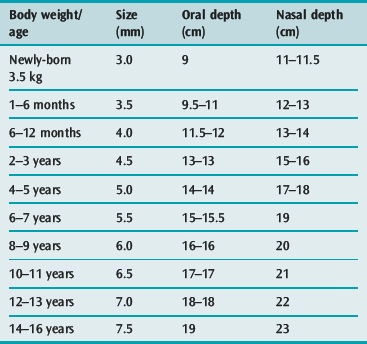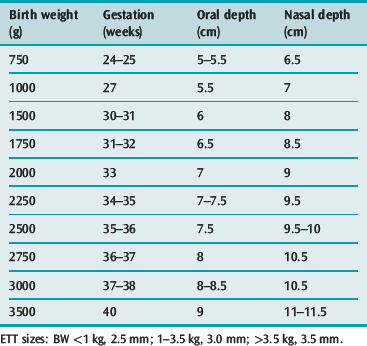Chapter 104 Equipment for paediatric intensive care
This chapter discusses equipment and its performance required in paediatric and neonatal intensive care. How to use equipment is not discussed. Examples of equipment are given, but exhaustive lists are not intended. Only essential equipment is considered.
AIRWAY MANAGEMENT
ENDOTRACHEAL TUBES
TUBE SIZE
A selection of sizes, one larger and one smaller than the anticipated size, should be available at intubation. Tube sizes according to body weight and age are given in Table 104.1 and 104.2. A rough guide for internal diameter size in the child is age (in years)/4 + 4 mm.
Table 104.2 Endotracheal tube sizes (internal diameter) and orotracheal and nasotracheal depths for infants and children

TUBE LENGTH (DEPTH)
The endotracheal tube tip should be located in the mid-trachea so that the risks of accidental extubation and endobronchial intubation are minimised. Correct positioning of the tube should always be checked by auscultation in the axillae, by chest X-ray immediately after intubation and daily thereafter.1 At intubation, visualisation of the depth of the tube passed through the cords should be a guide only, since the tube advances when the head is released from extension as the laryngoscope is removed.2
The lengths (depths) at which orotracheal and nasotracheal tubes can be chosen initially on the basis of weight or gestation in premature neonates are given in Table 104.1, and on the basis of age for infants and children in Table 104.2. The lengths are at the lips for oral tubes and at the exit from the nose for nasal tubes. For oral tubes, a guide to correct depth for 2 years and over is given by the formula: (age in years/2 + 12 cm), while for nasal tubes the formula is: (age in years/2 + 15 cm). The depth of insertion of any tube should be documented or marked on the tube.
SUCTION CATHETERS
Sizes 5, 6, 8, 10 and 12 FG should be available. The suction catheter should be large enough to remove secretions but not too large to occlude the endotracheal/tracheostomy tube lumen (Table 104.3). Many suitable types are available – differing in number and location of suction ports (end and side ports are needed) and whether the tip is angled or straight. Angled tips facilitate entry into the left main bronchus. Satin-finish types with smooth port edges are needed. Single use suction catheters may be reused up to 24 hours without adding to the risk of pneumonia.3 Closed suction systems permit suction without disconnection from ventilator as may be indicated during nitric oxide therapy, severe lung disease or frequent suction.
Table 104.3 Recommended suction catheters
| Internal diameter (mm) of ETT or tracheostomy | Recommended suction catheter (FG) |
|---|---|
| 2.5 | 5 |
| 3.0 | 6 |
| 3.5–5.5 | 8 |
| 6.0–6.5 | 10 |
| 7.0 and larger | 12 |
ETT, endotracheal tube.
OROPHARYNGEAL AIRWAYS
A range of Guedel airways (sizes 000, 00, 0, 1, 2 and 3) constructed of polyvinyl chloride with a metal insert should be available: an airway that is too small may be occluded by the surface of the tongue or displace the tongue backwards to obstruct the airway; an airway that is too large may enter the oesophagus. The correct size, when placed alongside the cheek, extends from the centre of the lips to the angle of the mandible. Nasopharyngeal airways are available for the older child, but any size can be constructed from an endotracheal tube. A guide to length is from the tip of the nose to the tragus of the ear.
MECHANICAL VENTILATION
RESUSCITATOR ‘BAGGING’ CIRCUITS
SELF-INFLATED BAGS
With Laerdal and Partner bags, negligible amounts of oxygen (0.1–0.3 l/min) issue from the patient valve when 5–15 l/min of oxygen is introduced into bags unconnected to patients.4 The valve is unlikely to open unless the mask is sealed well on the face. The delivered oxygen concentration is dependent on the flow rate of oxygen, use of the reservoir bag, and the state of the pressure relief valve (whether open or closed).
Other self-inflated bags include the Combibag, Ambu, AirViva and Hudson RCI.
MASKS
Masks should facilitate an airtight seal on the face with minimal dead space.
Masks with rims created by infolding of the body are more difficult to use.
MECHANICAL VENTILATORS
CONVENTIONAL VENTILATORS
A generic classification of ventilators, their operational characteristics and their modes of ventilation has been proposed.5 It is described here briefly to enable functional description and comparison of some ventilators.

Full access? Get Clinical Tree





